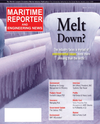
Page 19: of Maritime Reporter Magazine (May 2012)
The Green Ship Edition
Read this page in Pdf, Flash or Html5 edition of May 2012 Maritime Reporter Magazine
electronic card readers, similar to theubiquitous ATM card terminals. Individ- uals would swipe their TWICs (or hold it in close proximity, if a contactless reader was installed) and match the biometric information (fingerprints) to gain access. Fixed card readers are still being tested. Development of portable wireless card readers is several years away, at the ear- liest.The Department of Homeland Security(DHS) recently completed a pilot pro-gram to evaluate electronic TWIC card readers. DHS concluded that the TWIC reader systems function properly whenthey are designed, installed, and operated in a manner consistent with the charac- teristics and business needs of the facility or vessel operation. Important caveats were attached to this declaration of suc-cess. A number of operational and tech- nological difficulties were documented during the pilot program. Reader per- formance varied widely during the pilot. The time and effort required to install electronic readers and reader infrastruc-ture varied widely among pilot partici- pants. Extensive training was necessary for personnel operating the electronicreader system and some training was re- quired for individual card holders. Some readers experienced difficulty scanning fingerprints of the individual, particularly during inclement weather. One of the findings of the pilot program, not sur- prisingly, was that the conditions under which TWIC readers had to perform were significantly more challenging than those commonly found at office loca- tions.In May 2011, the Government Ac- countability Office (GAO) issued a report stating, in pertinent part, that the DHShas not assessed the TWIC program?s ef- fectiveness at enhancing security or re- ducing risk for MTSA-regulated facilities and vessels. Further, DHS has not demonstrated that TWIC, as currently implemented and planned, is more effec- tive than prior approaches used to limit access to ports and facilities. The DHS has not completed a risk-informed cost-benefit analysis that considers existing security risks and it has not completed aregulatory analysis for its upcoming reg- ulation on using TWICs with card read- ers.Issues regarding the TWIC program are numerous. The TWIC cards are not se- curely produced. Quality control duringthe production process is lacking. The cards are not substantial enough to standup to normal handling. They are easy to counterfeit. The electronic card readers only work, if at all, after much time, ex- pensive, and training of both the security staff and the card holders. This litany of problems has eroded in- dustry?s faith in the TWIC program. The TWIC card, as things now stand, is little more than a glorified and very expensive flash pass. The process has made it dif- ficult for individuals in the maritime in- dustry to obtain a legitimate TWIC card, while unauthorized persons can obtain afraudulent card for about $100. Underthe current program, the biometric trans-portation security card decreed by Con-gress in the heat of the moment following the horrific terrorist attacks on Septem- ber 11, 2001 ? the TWIC card ? is virtu- ally useless.Dennis L. Bryant, Maritime Regulatory Consulting,Gainesville, FL, Tel: 352-692-5493 Email: [email protected] May 2012 marinelink.com19MR May 12 # 3 (17-24):MR Template 5/8/2012 11:34 AM Page 19

 18
18

 20
20
